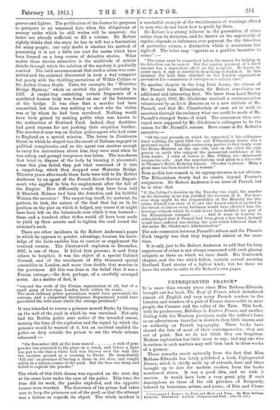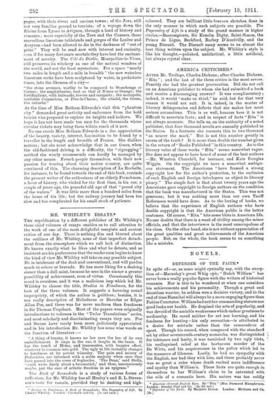UNFREQUENTED FRANCE.*
IT is more than twenty years since Miss Betham-Edwards brought out her book, The Roof of France, which introduced almost all English and very many French readers to the beauties and wonders of a part of France inaccessible to most people, the Causses and the valley of the Tarn. This book, with its predecessor, Holidays in Eastern France, and another dealing with the Western provinces, made the author's fame as an adventurous traveller in districts then little known and an authority on French topography. These books have shared the fate of most of their contemporaries ; they are out of print. But we do not think they are forgotten. Modern exploration has little more to say ; and any one who is curious in such matters may well turn back to these works of a pioneer.
These remarks result naturally from the fact that Miss Betham-Edwards has lately published a book, Unfrequented France, which is chiefly made up of extracts, here and there brought up to date for modern readers, from the books mentioned above. It was a good idea, and we wish it success. It would have been a eery great pity if such descriptions as those of the old province of Burgundy, beloved by historians, artists, and poets ; of Brie and Cham-
• Unfrequented France: by Riter and Mead and Town. By Miss BetBont- Edwards. Illustrated. London Mil =an and Hall. [10a. ed. Eat.]
pagne, with their rivers and ancient towns ; of the Jura, still not very familiar ground to tourists; of a voyage down the Rhone from Lyons to Avignon, through a land of history and romance ; more especially of the Tarn and the Causses, those marvellous limestone tablelands and gorges of the Lozere and Aveyron—had been allowed to die in the darkness of "out of print." They will he read now with interest and curiosity, even if for many fortunate mortals they have lost the enchant- ment of novelty. The Cite du Diable, Montpellier-le-Vieux, still preserves its witchery as one of the natural wonders of the world, and not the least mysterious. For a space "nearly two miles in length and a mile in breadth " the now waterless
limestone rocks have been sculptured by water, in prehistoric times, into the likeness of a city— "the stone avenues, worthy to be compared to Stonehenge or Carnac ; the amphitheatre, vast as that of Nimes or Orange; the fortifications, with bulwarks, towers and ramparts ; the necropolis, veritable Cerameicus, or Pere-la-Chaise; the citadel, the forum, the suburbs."
At the time of Miss Betham-Edwards's visit this "phantom city" demanded great activity and endurance from the bold tourist who proposed to explore its heights and hollows. We hope it has not been made too easy for the thousands whose circular tickets may bring them within reach of it now.
No one excels Miss Betham-Edwards in a due appreciation of the beauty, variety, interest, fascination to be found by a traveller in the length and breadth of France. She dislikes motors ; but she must acknowledge that in our times, when the old-fashioned driving is a difficulty, the " zigzagging " method she wisely recommends can hardly be managed by any other means. French people themselves, with their new passion for touring about their native country, are quite convinced of this. The charming description of La Rochelle, for instance, to be found towards the end of this book, reminds the present writer of the enthusiasm of an elderly Frenchman,
a lover of history, who visited for the first time, in his car, a couple of years ago, the peaceful old age of that " proud city of the waters." It was little more than a hundred miles from the home of his life; but the railway journey had been too slow and too complicated for his small stock of patience.







































 Previous page
Previous page